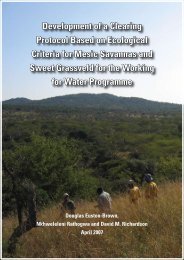Metsi Consultants - DWA Home Page
Metsi Consultants - DWA Home Page
Metsi Consultants - DWA Home Page
Create successful ePaper yourself
Turn your PDF publications into a flip-book with our unique Google optimized e-Paper software.
Negligible: 0% probability<br />
Minimal/Low: 1-20% probability<br />
Moderate: 21-40% probability<br />
Severe: 41-80% probability<br />
Critically severe: 81-100% probability.<br />
Report No 678-F-001<br />
METSI CONSULTANTS: SUMMARY OF MAIN FINDINGS FOR PHASE 1 DEVELOPMENT<br />
4.4. ONSET AND DURATION OF BIOPHYSICAL IMPACTS<br />
Predicted biophysical changes would take place over a range of time scales. Some impacts, once they had<br />
occurred, would change little thereafter, e.g., geomorphological changes, whereas others would likely be cyclical,<br />
e.g., the appearance of algal blooms. However, although the predicted (and reported) consequences represented<br />
the expected average condition of the rivers in the middle-term, there could be declines into a poorer condition.<br />
There could also be risks of the river condition fluctuating between extreme conditions. Table 4.2 summarises the<br />
most likely timing of the biophysical impacts identified in the study.<br />
Table 4.2 The anticipated onset, reversibility and possible periodicity of biophysical impacts.<br />
Component Sub-Component Onset<br />
Geomorphology Changes in habitat area and to the shape and complexity of the low flow channel Immediate<br />
Biofilm growth on the surfaces of boulders, cobbles and gravels 1-2 years<br />
Colloidal sediment (clay) deposition 2-10 years<br />
Quantity of fine sediments in the system e.g., mud 2-10 years<br />
Transport of sand -sized material 2-10 years<br />
Quantity of sand in the system 2-10 years<br />
Pool depth and number 2-10 years<br />
Movement of gravel/cobbles/boulders 2-10 years<br />
Riffle sedimentation (over time) 2-10 years<br />
Frequency of inundation of bar surfaces 2-10 years<br />
Flows which flush fine sediments from bar surfaces 2-10 years<br />
Frequency of bankfull flows 2-10 years<br />
Flood plain inundation >10 years<br />
Frequency of inundation of bench surfaces 2-10 years<br />
Reversibility: many predicted changes would have little impact in isolation but in combination they would result in major and probably<br />
semi-permanent changes to channel shape and habitat availability. Sediments settling into a pool would, over time, become compacted<br />
so that flows that could remove them in the past would no longer be able to do so. Once the changes had occurred and conditions had<br />
become well established, then the system would only be reset by an unusually large flood event, e.g., a 1:100 year flood.<br />
Water Quality Nutrient and TSS variability 1-2 years<br />
Nutrient and TSS magnitude 1-2 years<br />
Nutrient and TSS mobilisation 1-2 years<br />
Temperature – increase in daily variation Immediate<br />
Rapid-Bio-Assessment 1-2 years<br />
Dissolved Oxygen – chance of anoxic conditions 1-2 years<br />
Reversibility: assuming there are no major changes in land use, the water quality impacts would be reversible.<br />
Vegetation Aquatic zone: algae 1-2 years<br />
Aquatic zone: macrophytes 1-2 years<br />
Wetbank annuals 1-2 years<br />
Wetbank sedges and grasses 1-2 years<br />
Wetbank shrubs and trees (Salix zone) 2-10 years<br />
Drybank: tree/shrub zone 2-10 years<br />
20

















